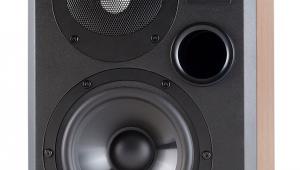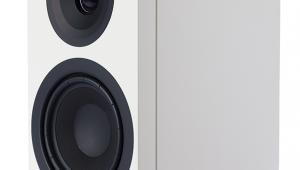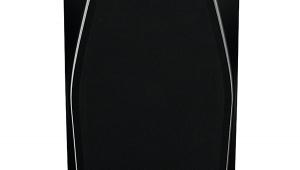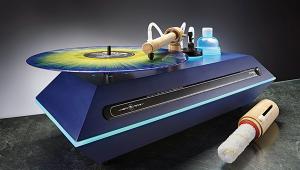Gamut Phi7 (£3940)
Gamut by name, gamut by nature. Danish audio company Gamut (it writes it GamuT), not content with offering eight models of loudspeaker, of which the Phi7 is top of the four-model Phi range, also manufactures a CD player, preamplifier, two integrated amps and four power amps plus interconnect and speaker cables. So it can supply you with an entire hi-fi system, wires included.
Phi in the context of this Gamut speaker and its siblings is the golden ratio, 1:1.618, which students of art and architecture will know from the aesthetically pleasing proportions of the golden rectangle. Mysteriously associated with everything from the Egyptian pyramids to Stradivarius violins – and no less arcanely employed by George Cardas in many of his cable designs – the golden ratio also forms the basis for favoured listening room dimensions which are said to offer an ideal distribution of standing wave frequencies. It is this last property which relates to Gamut’s use of the golden ratio within these speakers’ cabinet dimensions.
For instance, the channel which runs parallel to the front baffle through the Phi range’s side and top panels is not, as you might suppose, merely a decorative feature. Called the resonance control groove, it is a deliberately introduced weak spot in the cabinet structure, positioned in accordance with the golden ratio, to determine how the enclosure will resonate. In combination with interior stiffening members, also positioned with reference to the golden ratio, this – Gamut claims – divides the side panels into separate resonating areas which store less energy and exhibit faster decay, promising a loudspeaker with reduced cabinet-induced coloration and muddle.
In other respects the Phi7’s cabinet is more conventional, at least until you look it completely up and down and notice the novel support arrangement employed within its base. At each corner of the cabinet is a short, fold-out aluminium leg which pivots at its inner end so as to tuck under the cabinet when not in use. Above each leg is an aluminium knob, not unlike a small volume control, which turns a threaded rod that rests against the leg’s top surface, so that rotating the knob clockwise or anticlockwise either raises or lowers that corner of the speaker. This is not just to overcome the familiar problem of four feet being one too many for assured stability: it also allows the speaker to be tilted bodily backwards or forwards in order to align the tweeter axis with seated ear height, whatever your furniture and whether you are tall or short, ectomorph or endomorph.
PROVIDING STABILITY
The legs and their adjusters are carried on milled aluminium crossbars fixed to the bottom of the cabinet front and rear, and these provide for no other means of supporting the speaker. There are no screw threads to accept spikes, for instance, nor would they be appropriate given that one of the benefits of the pivoting legs is that they swing outboard of the speaker base, thereby rendering this tall, slim speaker more stable. On a hard floor this is all well and good but on carpet the legs do not provide a rigid foundation and are also sufficiently narrow to make deep depressions in the pile. In these circumstances many users may choose, like I did, to use the Phi7s on spiked platforms that provide a more rigid basis for the speakers and have less visible impact on the carpet.
As described in the box-out, Gamut uses four bass drivers in the Phi7, reflex loaded via two rear-firing ports, plus a single midrange driver and ring tweeter. The three-way crossover incorporates two proprietary technologies: NRLI, which involves the deployment of damping resistors within the network to control various resonances, electrical and acoustic; and DCCM (DC Coupled Midrange) which obviates the need for a high-pass section (and hence series capacitor) within the midrange network by connecting the negative terminal of the midrange driver not to earth, as usual, but to a point within the bass drivers’ low-pass filter circuit. In effect, then, the midrange high-pass slope is achieved using a subtractive technique. The crossover is split to allow bi-wiring or bi-amping, the upper pair of input terminals connecting to the tweeter section and the lower pair to the midrange and bass sections. Gold-plated shorting links are provided for single-wire operation.
FIRING STRAIGHT AHEAD
Like compatriot Dali, Gamut designs its speakers not to be toed-in towards the listening position but to fire straight down the room, an arrangement which ensures that the direct sound at the listening position and the first side wall reflection have more closely aligned spectral content. To counter the treble loss that would otherwise result from listening off-axis in this way, the Phi7’s on-axis frequency response displays a marked upturn in high frequency output. So if you do listen to it toed-in to face the listening position, the sound is notably hot in the treble, as a quick listen confirmed.
As you toe the speakers out to be parallel to the side walls the treble excess is curtailed, the imaging becomes more three-dimensional – real stereo rather than the cardboard cut-out effect that’s often portrayed as such – and the sound grows in dynamic authority. So there’s a marked improvement all round.
Experiments with the shorting straps between the two pairs of input terminals for single-wired connection proved interesting and fruitful, as it often does with speakers having split crossovers. With connection made to the lower pair of terminals the sound was slightly clouded and had a hard, harsh edge to it that, for example, could make violin tone a bit searing. Moving the cable connection to the upper terminals wrought a big change: the sound became more precisely defined – timbrally, spatially and dynamically – and that unpleasant rasp was removed or at least suppressed.
This encouraged me to remove the straps entirely and replace them with Chord Company Signature wired links instead – not so quick an operation as usual because Gamut’s straps don’t have slotted holes for the terminal posts, so the nuts at either end have to be completely removed before the strap can be lifted free – again with the speaker cable connection to the upper pair of terminals. Result: a smaller change than before but still a change. With the wire links in place the sound was a little less forward, a little smoother and the imaging a tad deeper but dynamics were marginally softened too. On balance I just preferred this presentation so I retained the Chord links for the remainder of the listening. Gamut offers it own WormHole terminal jumpers which may be an even better match.
ENGAGED SIGNS
With the Phi7 now tweaked to give of its best, I found it an engaging companion over, yes, the gamut of musical forms. I turned first, as I often do when seeking musical solace in its simplest, purest form, to The Intimate Ella [Verve 839 838-2] – a collection of classic songs inimitably sung by Ella Fitzgerald at the height of her powers, with only Paul Smith’s piano as accompaniment. Like many fine recordings of the 1950s and 1960s, this isn’t the last word in technical excellence but has an uncommon honesty of sound that lets the performance shine through. Good speakers do nothing to interrupt this direct line of communication; rather too many play Chinese Whispers and mangle the meaning.
BOTTLES AND BELLS
No such problem with the Phi7, which conjured up Ella and piano with great authority. All the more so when I’d taken trouble over setting those elaborate feet to get the tweeter pointing straight at my ears – an adjustment that proves well worth the effort. That said, the Phi7 isn’t quite tonally neutral: some listeners might crave a little more lower-mid warmth, and the lower treble is a touch prominent, adding a little whispiness to voice.
Quite what inspired me to play 10cc’s remastered One Night in Paris [Mercury 532 964-2] next I don’t know – actually I do: the disc caddy was on the floor and I almost trod on it – but it proved a good choice. Nothing short of disconnecting the tweeter will ever calm the fatuously boosted treble of this recording – you could cut steel with the cymbals accompanying ‘All our girls are, ’ow you say?, good in the sack’ – but the Phi7 did a fine job of separating the multiple strands of this early rock opera production with its numerous ‘noises off’, and presenting them across a wide, deep and stable soundstage. The smashing bottle, bicycle bell and car horn all sounded convincing, even if the hammed up fake French accents didn’t. But they never will. It also – a Phi7 characteristic, this – had very well controlled, hangover-free bass although, by the same token, it lacks the lowest, floor-shaking fundamentals. As Godley and Creme understood: that’s the way the croissant crumbles.
VERDICT
This unusually tall, imposing floorstander is arguably a little on the costly side but, in its favour, incorporates a lot of hardware (six drivers per side), embodies some novel touches including its golden ratio-based construction principles, and delivers a transparent, spacious and well-ordered sound that while not quite tonally neutral is always informative about both the music and the recording.
Originally published in the September 2009 issue

























































